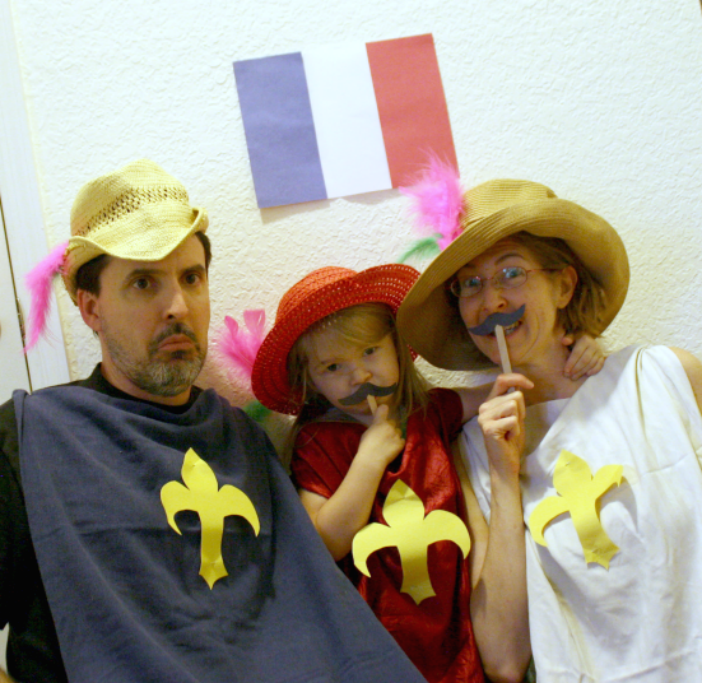
I studied Spanish all through high school and college, taught myself French (sort of) for fun one summer, learned various phrases to help me get by during all my European travels, and sat down to seriously study Italian when I met my husband G, who lived in Rome for 5 years during graduate school.

He also grew up in Miami, which (according to his jokey self) automatically makes him half Cuban, he spent one of his summers abroad attending French classes, he took Japanese in college and Latin in grad school. Besides that, the man just loves languages.
So, when our little Gv came along, we were eager to bring some of those different languages into her life as well.
Integrating Foreign Language Early
We’d been fiddling around with several of the suggestions you’ll find below, but Gv (who is 5) didn’t really have any great motivation herself to learn a language until a couple months ago, when I found an incredible deal on flights and announced that we’d be jetting off to visit France and Italy soon!
That changed things. Gv now wants to learn BOTH languages and has already been plastering the wall of our hall with index cards for many of the words in French and Italian that she most wants to learn.
I tell you, that motivation spark made all the difference in the world and Gv’s confidence in the few words and phrases that she knows at this point is through the roof – she proudly announces to everyone she sees that she knows how to speak French and Italian and has no qualms about trying out her new vocabulary on anyone who will listen!
Learning a new language is beneficial for everyone, but if you can find the way to spark your preschooler’s interest early on, you’ll especially reap some pretty fantastic rewards.
Benefits of learning a foreign language in preschool:
- Boosts Brain Development – did you know that learning a second language increases brain matter? Who doesn’t want a bigger brain?
- Capitalizes on a Natural Ability to Learn – the first 3-4 years of life are considered the prime time for language acquisition and studies have shown that if a child learns an additional language by the age of 8, he can become fluent without an accent!
- Improves Academic Performance – this doesn’t just mean higher test scores (although that will happen, too!), but better verbal communication, mathematical development and reasoning skills
- Encourages Out-of-the-Box Thinking – because of the mental gymnastics language-learners go through to communicate, their brains are better able to engage in creative thinking and become great problem-solvers
- Creates a Link to Heritage – even if you have to go back several generations, learning a language can be a great way for young children to connect to their ancestors
- Increases Cultural Awareness – foreign languages not only introduce young children to the rest of the world, but spark empathy and an understanding of differences, as well
- Helps with Native Language – it’s easier to navigate in your native tongue when you better understand how language works
- Promotes Future Opportunities – you might not want to think this far ahead with your tiny tot, but early experiences with a second language can lead to better job opportunities later on!
Maybe your family isn’t about to cross an ocean like ours is, but the motivation for your kids to learn a new language might come from a friend or family member who speaks it, a love for a movie or book character like this one, or simply having an interest in a particular city (like our little Eiffel-Tower-obsessed gal!)
Foreign Language Resources
So, now that I’ve got you convinced to introduce your kids to another language, here are some great ways to go about it:
- TalkBox.Mom – read all about this great subscription series here. What I love most about this product is that its focus is all about just diving in and using the new language every day, which makes total sense, since that’s how we all learn to communicate in the first place as babies! This option does require a bit of a monetary investment, but it is so much smarter than most of the other paid-language-learning options out there because you actually start speaking it from the moment you open the box!
- Duolingo – I’ve shared this free app with my readers before and I wouldn’t say that it’s the best for preschoolers to use (it involves too much reading and typing for them), but it’s a great way for moms and dads to practice their skills. It takes only a couple of minutes a day and is a much better way to spend a brain break than yet another glance at social media!
- The Library – I know I go on and on about how amazing the library is, but it really offers so many free resources that I just can’t help it. You might find children’s picture books in your chosen language, music CDs, kid’s cartoon DVDs, or even free subscriptions to other language-learning apps and software!
- YouTube – Our library has a ton of Spanish resources, but only a handful in Italian. We constantly turn to YouTube and often spend our lunchtimes watching Peppa Pig or Little Kingdom in italiano, or play Italian tunes in the background during our day. I’ve even found full-length Disney movies dubbed in Italian on there, which really ups the motivation factor for Gv!
- Magazine Subscriptions – you can subscribe to a bilingual version of made-for-preschoolers High Five Magazine — or if Spanish isn’t your thing, check around to see if there are any magazines available in your family’s language of study!
- Activity Books – I’ve got my eye on this Italian coloring book for Gv, but kids around the world all enjoy activity books, so think about picking up one for your family to have fun with!
- Games – you might need to head over to eBay for this one, but after just a quick search, I found an Italian version of Monopoly, which would be easy to play since we’re already so familiar with the English board game.
- Create a Monthly Cultural Night – we spent two years “traveling” the world each month, but instead of hopping from country to country like we did, you could just re-visit the locations where your new language is spoken and spend the night concentrating on communicating only that way.
Other than those specific places to find resources, try looking for ways to incorporate the new language into your everyday life as much as possible. Read fairy tales or picture books that are written in that language, listen to music, watch movies dubbed in that language or even just turn on the closed captioning in that language for whatever you watch – G and I pretty much turn French subtitles on for anything we watch and you wouldn’t believe how much of a help that is to keeping up our skills!
Also, take the concept that TalkBox.Mom follows and try substituting words and phrases that you use every day into your speech. I mean, how many times do you tell your kids to put on their shoes or get in the car?
Yeah. That’s what I figured.
Start telling them this in the new language and you can bet they’ll learn it before you can blink!
Whatever you do, just dive right in. Learning a new language doesn’t have to feel like drudgery, it can be fun! And it’s never too early to get your kids in on the fun!
Can you think of a motivation for your kids to learn a new language? I’d love to hear! Either leave a comment below or email me at lisahealy (at) oulook (dot) com.
- 5 Easy Ways to Incorporate Preschool Math into Your Homeschool Day - September 29, 2022
- Preschool At Home: Calming Your Fears - August 31, 2022
- Homeschooling Your Preschooler: Social-Emotional Learning Guide - July 25, 2022


